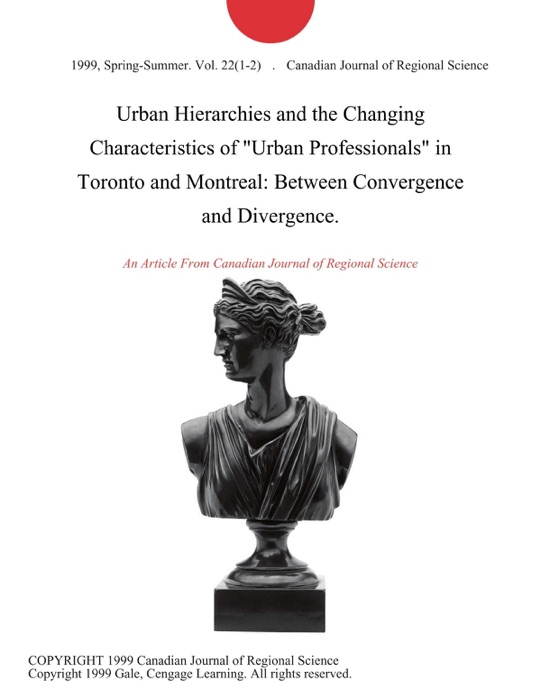(DOWNLOAD) "Urban Hierarchies and the Changing Characteristics of "Urban Professionals" in Toronto and Montreal: Between Convergence and Divergence." by Canadian Journal of Regional Science # eBook PDF Kindle ePub Free

eBook details
- Title: Urban Hierarchies and the Changing Characteristics of "Urban Professionals" in Toronto and Montreal: Between Convergence and Divergence.
- Author : Canadian Journal of Regional Science
- Release Date : January 22, 1999
- Genre: Social Science,Books,Nonfiction,
- Pages : * pages
- Size : 236 KB
Description
It has been amply demonstrated in the literature that the decade of the 1980s was a crucial one as regards what Ley (1996) terms the "shuffling of command and control" in the Canadian urban system. Toronto's position at the summit of the Canadian urban-economic hierarchy became more firmly entrenched than ever before, with the region increasing its lead over the country's other major advanced tertiary centres in terres of employment in the pivotal financial and business services sectors (Coffey 1994; Ley and Hutton 1991; Polese 1998). By 1991, some 25% of the Toronto Census Metropolitan Area's service sector jobs were in finance, insurance, real estate and business services, compared to 20% in the case of Vancouver and 19% in Montreal (Statistics Canada 1994). The 1980s also saw the continuation, if hot the culmination, of the decades-long process of shift of Canadian head offices in finance and other crucial sectors of the economy from Montreal to Toronto. Detailed occupational data from the 1996 census underline the supremacy of Toronto in terms of both the absolute and relative numbers of high-level managerial and professional positions in the financial sector (Statistics Canada 1998). Moreover, for senior management occupations in general, the 1995 earnings of those in Toronto were on average almost 40% higher than those of their Montreal counterparts -- a telling indicator of the relative importance of the two cities in high-level corporate decision-making. The 1980s also saw a continuation and consolidation of the process of restructuring of the occupational composition of the labour force resident in the inner cities not only of Toronto and Montreal but of all of Canada's major advanced tertiary centres. The overall trend has been one of rising skill levels or "professionalisation", resulting both from an increase in the numbers of high-level advanced tertiary sector workers in the inner city and from a decline in the numbers employed in manufacturing (Ley 1996). Despite differences in operational definitions, researchers concur that "urban professionals" or the "professional-managerial class" have been over-represented in the inner city compared to the outer city at least since 1981 and that this over-representation increased during the 1990s (Ley 1996; Rose 1996). It is well-established that a strong presence of advanced tertiary sectors in the central city -- sectors that have a high concentration of professionals in their workforce -- is a necessary condition for the emergence and persistence of the gentrification or embourgeoisement of inner-city neighbourhoods, although it is not a sufficient condition in the absence of other factors that make the inner-city more appealing than the suburbs to members of this group (sec e.g. Bourne 1992; Butler and Hamnett 1994; Caulfield 1994; Ley 1988; Rose 1987). In addition, the increase in numbers of high-income urban professionals and managers has also contributed to the replenishment of long-standing elite areas of Canadian inner cities (e.g. Rosedale, Westmount).
Post a Comment for "(DOWNLOAD) "Urban Hierarchies and the Changing Characteristics of "Urban Professionals" in Toronto and Montreal: Between Convergence and Divergence." by Canadian Journal of Regional Science # eBook PDF Kindle ePub Free"